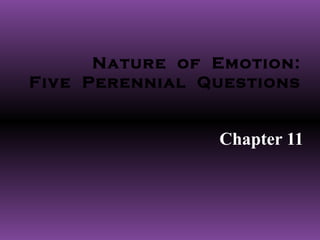
Ch11
- 1. Nature of Emotion: Five Perennial Questions Chapter 11
- 2. FIVE QUESTIONS 1. What is an emotion? 2. What causes an emotion? 3. How many emotions are there? 4. What good are the emotions? 5. What is the difference between emotion and mood?
- 3. WHAT IS AN EMOTION? Feelings Bodily Arousal • Subjective Experience • Physiological Activation • Phenomenological Awareness • Bodily Preparation for Action • Cognition • Motor Responses EMOTIO N Social-Expressive Sense of Purpose • Goal-Directed Motivational State Significant • Social Communication Life Event • Facial Expression • Functional Aspect • Vocal Expression Figure 11.1 Four Components of Emotion
- 4. Four Components of Sadness Feelings Bodily Arousal • Aversive • Decreased heart rate • Negative • Low energy level • Feeling of distress Sadnes s Sense of Purpose Separation from a Loved Social-Expressive • Wanting to take action to One, Failure on an • Inner Eyebrows raised overcome or reverse separation Important Task • Corners of lips lowered or failure • Crying, trembling
- 5. Definition of Emotion Emotions are short lived, feeling-arousal- purposive-expressive phenomena that help is adapt to the opportunities and challenges we face during important life events Different aspects of emotion complement and coordinate with one another
- 6. Relationship Between Emotion and Motivation
- 7. WHAT CAUSES AN EMOTION? Cognitive Processes Feelings Significant Situational Sense of Purpose Event Biological Bodily Arousal Processes Social-Expressive Figure 11.3 Causes of the Emotion Experience
- 8. Two-Systems View Parallel, Interactive, & Significant Coordinated Stimulus Output to Event Activate and Regulate Emotion Figure 11.4 Two-Systems View of Emotion
- 9. Chicken-and-Egg Problem Plutchik (1985) • Cognition versus biology debate as a chicken-and-egg quandary. • Emotion is a chain of events that aggregate into a complex feedback system. Significant Stimulus Emotion Event Figure 11.5 Feedback Loop in Emotion
- 10. How Many Emotions Are There?
- 11. Basic Emotions Themes of Basic Emotions Positive Emotions Negative Emotions Motive Treat and Harm Involvement and Satisfaction
- 12. Fear Arises from a person’s interpretation that the situation he or she faces is dangerous and a threat to one’s well being Common fear activating situations are rooted in the anticipation of physical or psychological harm, a vulnerability to danger, or an expectation that one’s coping abilities will not be sufficient Fear motivates defense Can provide motivational support for learning new coping responses
- 13. Anger Belief that the situation is not what it should be Most passionate emotion Also most dangerous Angry person becomes stronger and more energized Increases one’s sense of control, sensitivity, and awareness of the injustices of what other people do
- 14. Disgust Involves getting rid of or getting away from a contaminated, deteriorated, or spoiled object Function of disgust is rejection Plays a positive motivational role in our lives Ex. We engage in behaviors like washing the dishes, brushing our teeth, taking showers, and working out to avoid an out-of-shape or “disgusting” body
- 15. Sadness Most negative, aversive emotion Arises principally from experiences of separation or failure Motivates the individual to initiate whatever behavior is necessary to alleviate the distress- provoking circumstances before they occur again Ex. The rejected lover apologizes, sends flowers, or telephones to repair the broken relationship Feels miserable but can motivate and maintain productive behavior
- 16. Joy Desirable outcomes bring joy- success at a task, personal achievement, progress toward a goal, getting what we want, gaining respect, receiving love or affection, receiving a pleasant surprise Opposite emotion of sadness Joy facilitates or willingness to engage in social activities Joy has a “soothing function” Allows us to preserve psychological well-being
- 17. Interest Most prevalent emotion in day to day functioning Some level of interest is ever-present Interest creates desire to explore, investigate, seek out, manipulate, and extract information from the objects that surround us
- 18. What Good Are The Emotions?
- 19. Coping Functions Table 11.1 Functional View of Emotional Behavior (Plutchik, 1980) Emotion Stimulus Situation Emotional Behavior Function of Emotion Fear Threat Running, flying away Protection Anger Obstacle Biting, hitting Destruction Joy Potential mate Courting, mating Reproduction Sadness Loss of valued person Crying for help Reunion Acceptance Group member Grooming, Sharing Affiliation Disgust Gruesome object Vomiting, pursing away Rejection Anticipation New territory Examining, mapping Exploration Surprise Sudden novel object Stopping, alerting Orientation
- 20. Social Functions Emotions 1. Communicate our feelings to others. 2. Influence how others interact with us. 3. Invite and facilitate social interaction. 4. Create, maintain, and dissolve relationships.
- 21. What Is Difference Between Emotion And Mood? Criteria Antecedents Action- Specificity Time course
- 22. Everyday Mood Positive affect and Negative affect are independent ways of feeling.
- 23. Positive Affects Everyday, low-level, general state of feeling good.
- 24. “The Emotions aren’t Always immediately Subject to reason, but they are always immediately subject to action” ~ William James
